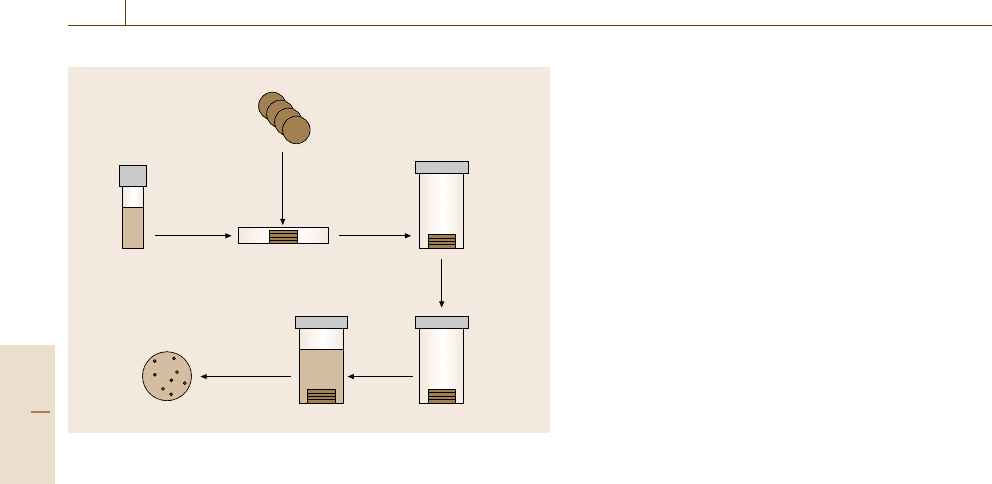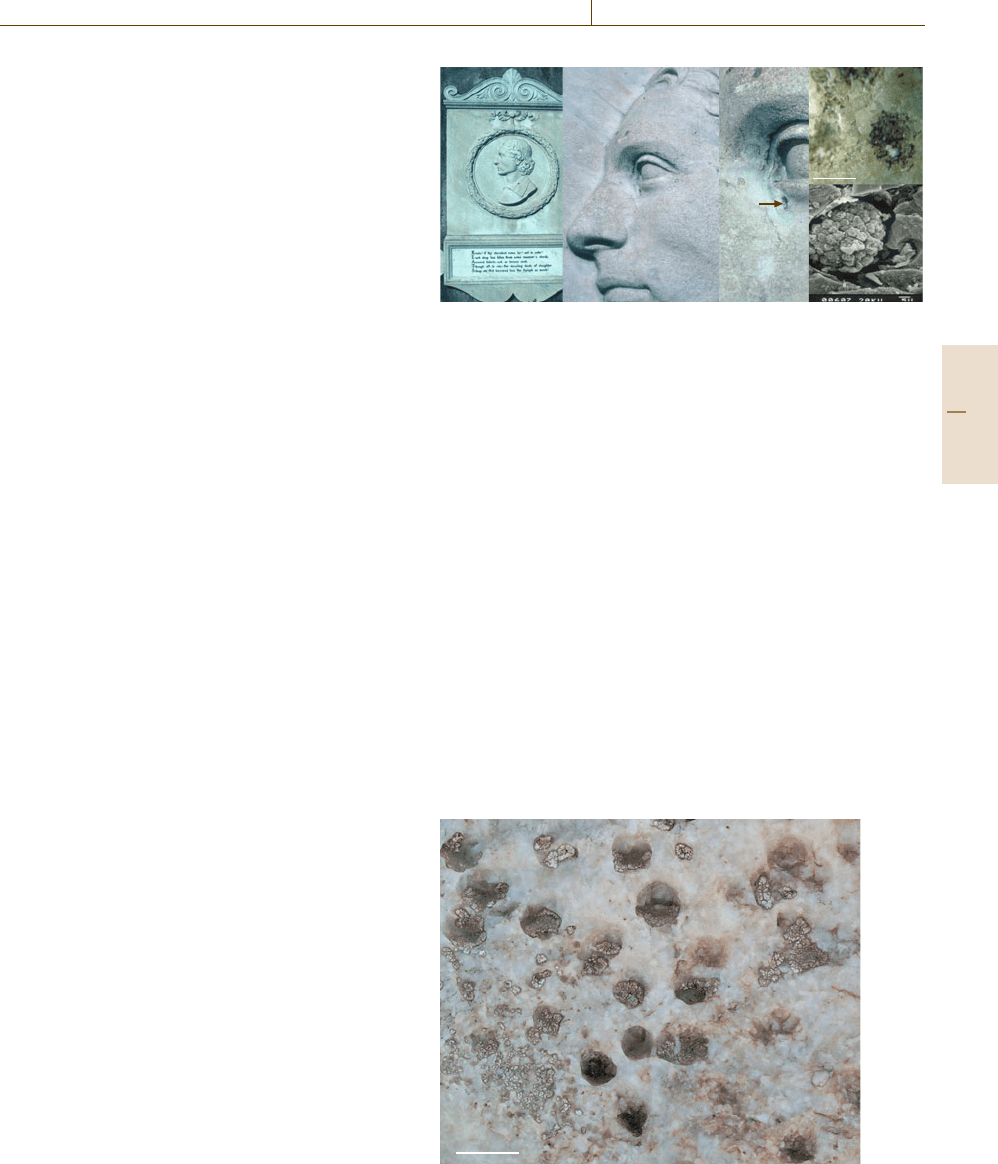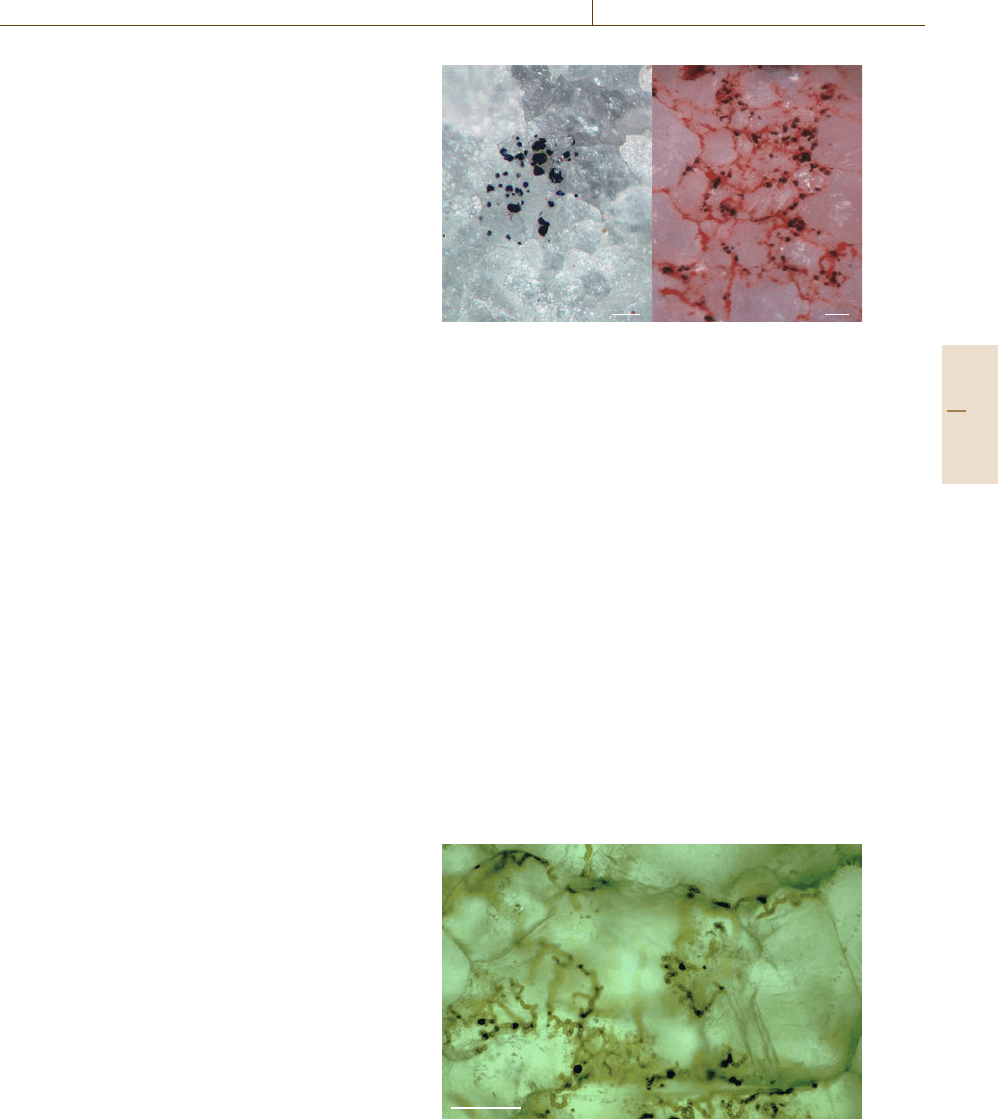Czichos H., Saito T., Smith L.E. (Eds.) Handbook of Metrology and Testing
Подождите немного. Документ загружается.


808 Part D Materials Performance Testing
Table 14.10 (continued)
Reference Title Description Major principle
EN ISO 20645 Textile fabrics – Determi-
nation of the antibacterial
activity – Agar plate test
(ISO 20645:2004)
Four replicate samples of fabric (25±5 mm) are placed in intimated
contact with a solid nutrient medium in a petri dish. The samples
are then overlaid with molten solid nutrient media which has been
inoculated with a cell suspension of either Staph aureus, Escherichia
coli or K pneumoniae. The plates are then incubated for between
18 and 24 h and the plates are then assessed for growth based
on either the presence of a zone of inhibition of > 1mm or the
absence/strength of the growth in the media overlaying the test
specimen
Zone diffusion
assay
ISO 20743 Textiles – Determination of
antibacterial activity of anti-
bacterial finished products:
Absorption method
Replicate (6) samples of textile are inoculated with a standardised
broth culture of either staph aureus or K pneumoniae in individual
tubes and then incubated at 37
◦
C for 18–24 h in closed containers.
Samples are analysed for the presence of viable bacteria both before
and after incubation by either total viable count or the determination
of total AT P. Samples are sterilised prior to testing and a neutraliser
is employed during recovery. The test is validated by growth of 1
order of magnitude during the incubation period
Cell suspension
intimate contact
test
ISO 20743 Textiles – Determination of
antibacterial activity of anti-
bacterial finished products:
Transfer method
Replicate (6) samples of test material are placed in contact with
an agar plate that has been inoculated with a specified volume
of a known cell suspension of either staph aureus and K pneu-
moniae using a 200 g weight for 1 min. The samples are then
removed. Replicate (3) samples are analysed for the either the
number of viable bacteria or the total ATM content both before
and after incubation under humid conditions at 37
◦
C for 24 h.
Samples are sterilised prior to testing and a neutraliser is em-
ployed during cell recovery. The test is validated by either growth
of 1 order of magnitude during the incubation period or by a measure
of the variability of the data obtained
Cell suspension
intimate contact
test
ISO 20743 Textiles – Determination of
antibacterial activity of anti-
bacterial finished products:
Printing method
Replicate (6) samples of test material are either staph aureus and
K pneumoniae by printing cells collected on a membrane filter
onto their surface in a standardised manner. The samples are then
incubated under humid conditions for 18–24 h at 20
◦
Cfora
specified contact time(s). Replicate (3) samples are analysed for
the either the number of viable bacteria or the total ATM content
both before and after incubation. Samples are sterilised prior to
testing and a neutraliser is employed during cell recovery. The test is
validated by either determining the survival of the inoculum on the
control material
Dry inoculum
intimate contact
test
SN 195920 Examination of the antibac-
terial effect of impregnated
textiles by the agar diffusion
method
Four replicate samples of fabric (25±5 mm) are placed in intimated
contact with a solid nutrient medium in a petri dish. The samples
are then overlaid with molten solid nutrient media which has been
inoculated with a cell suspension of either staph aureus or E. coli.
The plates are then incubated for between 18 and 24 h and the plates
are then assessed as described in prEN ISO 20645 above
Zone diffusion
assay
SN195924 Textile fabrics – Determina-
tion of the antibacterial
activity: Germ count
method
Fifteen replicate samples (each replicate is comprised of sufficient
specimens of 25 ±5 mm to absorb 1 ml of test inoculum) are
inoculated with cells of either E. coli or staph aureus suspended in a
liquid nutrient medium and incubated in sealed bottles for up to 24 h
at 27
◦
C. After 0, 6 and 24 h, 5 replicate samples are analysed for the
size of the viable population present. A neutraliser is employed. An
increase of
2 orders of magnitude of the population exposed to a control sample
is required to validate the test. The method defines a textile as anti-
bacterialifnomorethanaspecifiedminimumlevelofgrowthis
observed after 24 h in 4 of the 5 replicate groups of samples
Cell suspension
intimate contact
test
SN195921 Textile fabrics – Determina-
tion of antimycotic activity:
Agar diffusion plate test
Zone diffusion
assay
Part D 14.3

Biogenic Impact on Materials 14.3 Testing of Organic Materials 809
Table 14.11 Methods used to examine the antimicrobial activity of carpets
Reference Title Description Major principle
AATCC 174-2007 Antimicrobial Activity
Assessment of Carpets
Qualitative Antibacterial
Activity
Petri dishes with nutrient media are inoculated with
a single, diagonal streak (≈7.5 cm) of either staph aureus
or K pneumoniae. An unsterilized test specimen (25 mm×
50 mm) is placed in intimate contact and transversely
across the inoculum on the agar surface. The plates are
then inoculated at 37
◦
C for 18–24 h. The front and back
of the carpet are tested separately. After incubation, the
plates are inspected for the presence of growth both below
the specimens and for any zone of inhibition caused by
the specimen is recorded. The test can also be used to
test the effect of cleaning regimes. An untreated control is
optional
Qualitative assessment
of rate of kill and zone
diffusion test
AATCC 174-2007 Antimicrobial Activity
Assessment of Carpets
Quantitative Antibacter-
ial Activity
Unsterilized specimens of carpet are pre-wetted with
either sterile water or a wetting agent before being
inoculated with individual suspensions of either staph
aureus or K pneumoniae in either a low or a high
nutrient solution. The samples are then incubated in
a tightly closed jar at 37
◦
C for a specified contact time.
Cells are recovered in 100 ml of a neutraliser after 0 and
6–24 h of incubation. Activity is assessed by comparing
the size of the initial population in the control (if used)
with that present following incubation. A control is
optional. When not employed, viable counts following
incubation of the treated specimens alone are considered.
The test can also be used to test the effect of cleaning
regimes
Cell suspension in-
timate contact test
treated textiles which are not related to the prevention
of biodeterioration. In the first, typified by AATCC 147,
samples of textiles are placed onto agar plates which
have been inoculated with bacteria and then incubated.
The intention is that intimate contact between the tex-
tile and the bacteria/growth medium will result in the
inhibition of growth either immediately adjacent to
the textile or in an area around the textile, in case
any antimicrobial agents that have been employed be-
come dissolved in the growth medium. These methods
are generally acknowledged as being nonquantitative
although they can be employed as assays of certain
antimicrobial products in the same manner that such
techniques are used for certain antibiotics [14.105].
As with some of the biodeterioration tests described
above, this could be useful as a screening tool and
for investigating the effect of wash cycles etc. These
methods are widely employed in the textile indus-
try as they provide a highly graphic representation of
antimicrobial activity although this can lead to misun-
derstandings of either the scale of effect seen (bigger
zones of inhibition looking better) and the implica-
tions that mobility of active ingredient could have on
service life. Although these techniques are considered
to be unsuitable for quantifying the effect of the an-
timicrobial effects of treated textiles there are some
disciplines in which they may provide data which is
more relevant to the effect claimed than that delivered
by a fully quantitative technique (e.g., predicting the
effect/durability of bandages intended for use of sup-
purating wounds).
From Table 14.10 it can be seen that there are at
least four techniques which provide quantitative data
on the effect of treated textiles on bacteria. These are
typified by the method described in AATCC 100-2004
in which samples are inoculated with suspensions of
bacteria and then incubated for a specified time be-
fore being examined for the size of the population
present (Fig. 14.14). The methods differ in the form
of the suspension medium, number of replicates exam-
ined, test species and, to a certain extent, conditions for
incubation. Methods AATCC-100 and JIS L 1902 ap-
pear to be the most commonly employed. The Swiss
Standard SN195924 was based on AATCC 100 but
was apparently modified to improve reproducibility and
repeatability [14.106]. These methods show a clear
potential as being suitable to determine both inher-
ent bactericidal and bacteriostatic properties of textiles.
Although primarily developed for examining effects
against bacteria, they can be extended to the inves-
tigation of the impact on yeasts, fungal spores and
mycelial fragments. The impact on other species of
Part D 14.3

810 Part D Materials Performance Testing
AATCC 100
Sufficient replicate
swatches to absorb
1ml inoculum
Swatches inoculated
with 1 ml
broth culture
Test species grown
in broth and diluted
with broth to
1–2 ×10
5
CFU ml
–1
Samples
transferred
to jar
Incubated
at 37°C
for 18–24 h
100 ml neutraliser addedDetermine TVC
Fig. 14.14 Schematic representation of AATCC 100
bacteria can also be investigated. It is possible to en-
visage the method being extended to the examination
of viral particles, algae and protozoa. In addition, such
protocols can be combined with studies on ageing
(e.g., the impact of washing cycles) to begin to sat-
isfy at least some of the aspects associated with service
life.
It can also be seen from Table 14.10 that no fully
quantitative methods exist for the examination of treated
textiles on fungi. All of the protocols described are zone
diffusion assays of one form or another. As with antibac-
terial properties, these may be sufficient to substantiate
certain claims (e.g., that certain fungi significant to in-
fections on the human skin cannot germinate and grow
on the textile) and methods designed for the measure-
ment of the potential for/prevention of biodeterioration
could be employed dependent on the claim being made
(e.g., EN 14119: 2003 – Table 14.10) as well.
In addition to the truly microbiological methods de-
scribed above, at least three methods exist which de-
scribe the performance of woven textiles [14.107]and
nonwoven textiles [14.108, 109] to penetration by bac-
teria under wet and dry conditions. Further information
is required to determine whether these have any use in
evaluating treated textiles.
Although no specific standards exist for the exam-
ination of antimicrobial effects on paper and board, in
many cases the tests intended for textiles can be em-
ployed. One method (DIN EN 1104) uses a zone dif-
fusion assay to look for the presence of antimicrobial
agents in paper destined for food contact applications,
the intention here being to prevent the transfer of any
antimicrobial agents used in both the production of and
to prevent the biodeterioration of the paper/board being
transferred to food.
Selection of Test Method
For assessing potential biodeterioration and the effi-
cacy of treatments intended to prevent it, the choice of
methodology is relatively straightforward and is driven
either by a specification to be matched (e.g., a military
specification) or by the need to simulate an effect ob-
served in service. In some cases, microorganisms that
have caused failure in the field can be isolated and uti-
lized in laboratory tests although care should be taken
to use sufficient species/strains to measure an adequate
spectrum of activity. Selecting a method to simulate
a nonbiodeterioration-related effect is, however, more
problematic. Although many of the methods described
above and in the tables below can be used to give
a measure of an antimicrobial effect, it is important to
ensure that this effect and the method used to measure
it, is relevant to the application. For example, it may
be sufficient to merely slow bacterial growth in a ap-
plication intended to reduce the generation of odorous
compounds from human perspiration. In this instance
a test such as that described in AATCC 100 may be
modified using species known to biotransform com-
pounds in human sweat to odor-forming molecules. The
presence of moisture in the system could be consid-
ered as a reasonable model of certain items of sports
clothing (e.g. socks) and the temperature used/contact
time employed could be altered if necessary to bring
the test closer to reality. However, in many other ap-
plications such tests provide a poor simulation of the
end use. For example, a method that uses a cell sus-
pension to saturate a sample which is then incubated
at 37
◦
C for 24 h cannot be considered as a suitable
simulation of textiles used for soft furnishings and the
uniforms of medical staff. In normal use these mater-
ials would be dry or at worst occasionally splashed with
water/fluids containing microorganisms. Not only do
the test conditions not simulate the normal environment
of the textile in use, but they may artificially predict an
effect where none would result in practice. Many an-
timicrobial agents require free water to facilitate their
transfer from a material in which they are contained to
a microbial cell that comes in contact with the mater-
ial. Similarly, all microbial cells require free water to
grow and many also require it to survive for any length
of time. If either no or insufficient free water is present
in an application then it is unlikely that an antimicro-
bial agent would migrate from a material to a cell or
Part D 14.3

Biogenic Impact on Materials 14.4 Biological Testing of Inorganic Materials 811
that the cell would be in a suitable metabolic state to
interact with the active ingredient. In some instances,
the inclusion of an active ingredient might be to add
potential activity which would provide function if suit-
able conditions were to arise (in a similar manner to
the use of a fungicide in a textile intended to prevent
mold growth should conditions suitable for growth oc-
cur – i. e., keeping the item dry would have the same
function in most cases). In this instance care needs to
be taken to understand what the effect one is trying to
simulate is. If for example, it is to prevent cross infec-
tion from one patient to another by contact with the
uniform of medical staff, the speed of action will be
a critical factor. Not only will the level of moisture need
to be selected to simulate the conditions (e.g., moisture
from hand contact, a splash with a body fluid such as
sputum) but the contact time will need to reflect the
interval in which cross contamination might occur (po-
tentially very short intervals in a busy clinical unit).
In some circumstances, a significant level of moisture
may simply never be present (e.g., during the settle-
ment of airborne bacteria onto curtains). Methods are
being developed which attempt to simulation such con-
ditions (e.g., the printing method stage of ISO 20743)
although care must be taken to ensure no artifacts are
introduced in the recovery phase of such techniques.
Considerable work is still required before many of the
claims made for treated textiles/paper can be substan-
tiated and their true benefit be assessed in a robust
manner.
14.4 Biological Testing of Inorganic Materials
Ageing applies more or less to all materials. This
natural decay process is ruled by physical and chem-
ical interactions with the environment and can be
considerably accelerated and in some special cases
slowed down by the interaction with organisms and
especially microorganisms. The microbes involved are
wide-ranging in speciation and at the same time often
very specialized in their nutritional and environmen-
tal adaptations. Adhesion to surfaces and resistance
to stressed conditions are of importance as well as
special biochemical pathways to furnish energy, elec-
trons, water and mineral matter to the microbes living
on and in inorganic materials. In order to understand
detrimental functions and reaction chains, new meth-
ods of study and differentiation of physical, chemical
and biologically induced or accelerated processes had
to be developed. Quantitative data on mere physical
and chemical attack in comparison to biologically in-
duced and catalyzed biotransformations and biotransfer
processes had to be compared in laboratory and field
experiments. Methods of curing, protection, steriliza-
tion, biocide treatments had to be especially conceived
and tested. Studies on the speed of physical/chemical
deterioration as compared to biodeterioration were
undertaken. In conclusion it can be stated that all in-
organic materials exposed to surface conditions are
more rapidly transferred and cycled biologically than
under conditions of a sterile environment and atmo-
sphere. Although water plays an eminent role in all
biotransfer processes, it is shown that biologically in-
duced accelerations of decay and ageing of materials
takes place in practically all objects of industry, daily
use, and of the cultural heritage. Examples of sub-
aquatic and subaerial biofilms on inorganic surfaces
and microbial networks (biodictyon) inside porous or
damaged materials are given as well as the techniques
to study them and eventually prevent their damaging
potential.
14.4.1 Inorganic Materials Subject
to Biological Attack
Generally, the decomposition of inorganic materials is
related to empirical observations and even to subjec-
tive impressions. The physical, chemical and biological
processes are usually not well understood. Thus every-
body expects that granite, for example (or any stone)
is more durable than tissue (or any other organic ma-
terial). Some tombstones, however, decay so fast that
the son may survive the inscriptions made to commem-
orate his own parents. Thus in an exclusively physical
environment, it is evident that the decomposition of
rock and the dissolution of rock-forming minerals pro-
ceeds much faster than the physical decay of a protein
or carbohydrate. We can state that practically all ma-
terials used in the production of objects, buildings and
machines will ultimately decay. Biologically induced
or accelerated decay processes are, however, often un-
derestimated. Acceleration rates of up to 10 000 × have
been found in comparative laboratory experiments and
field observations. The physical and chemical environ-
ment and conditioning of all objects of commercial and
Part D 14.4

812 Part D Materials Performance Testing
cultural value will determine (1) the longevity of any
object and (2) the chances of biological attack and bio-
logical catalysis of the natural physical decomposition
processes. One simple example is the aggressiveness of
water on a marble statue. Distilled pure water has an
extremely low dissolution capacity as only a minimal
amount of protons are available. Marble in the vicin-
ity of a bakery or a restaurant, however, absorbs volatile
organic compounds, which – humidity given – will be
transformed to carbonic acid by ubiquitous microbes.
The aggressive action of water is modified through var-
ious biological processes. Therefore, a durability scale
of materials will largely depend on the environmental
and biological conditions. However, we can now say
more specifically which inorganic materials are more
susceptible to biological attack and biodeterioration as
compared to others. In the following pages we will,
after a short introduction on materials, focus mainly
on the organisms and biological phenomena and pro-
cesses involved in the deterioration of objects made
of inorganic materials. We will introduce some mod-
ern terminology, describe methods of study and ways
for protection of the inorganic materials from biological
hazards.
Mineral Materials
Most buildings, sculptures and objects of use are pro-
duced from rock types found and procured locally.
Since the Egyptian, Greek, Hellenistic and Roman
times, however, international trading of beautiful and
often most durable rock types is documented and the
multiple use and transfer of materials such as Pen-
telic and Carrara marble, Egyptian porphyry and granite
stones and objects is well documented, with famous
examples of porphyry columns transferred from Egypt
to Rome and from Rome to Provence etc. or Egyp-
tian obelisks being transferred to modern cities such as
Paris and London. Vitruvius in his time made a sur-
vey on their durability and thus, with the exclusion of
cases where cheap materials were used, the more im-
pervious rocks were traditionally used in production of
objects if the future owner was ready to pay enough
money.
Calcareous Materials. Calcium carbonate is a mostly
biologically deposited mineral. It is produced by skele-
tal macroorganisms or from the byproduct of bacterial-,
fungal- and algal metabolic activities. The so-called
structure-less carbonate rocks and carbonate cements
of sandstones are usually biologically catalyzed de-
posits. Marble is a pressure-temperature metamorphosis
of limestone. Traditionally, travertines and carbonate
tuffs (fresh-water deposits of calcium carbonate pro-
duced by carbon dioxide uptake through algae and/or
by equilibration of water highly enriched with carbon
dioxide) are regarded as high quality materials because
it is very easy to cut and treat them in a wet state,
while they harden when drying. Many colored mar-
bles (carbonate breccia) are of Alpine Triassic origin.
The yellow to brown color of many limestone-derived
marbles comes from small amounts of iron oxide
admixed. These are especially susceptible to the for-
mation of brown or red films and crusts often called
scialbatura or oxalate films. Since Roman times, cal-
cium carbonate has also been used as a compound
in the production of mortar, stucco and mural paint-
ings. Because the physical and biological mechanisms
of decay are practically the same, we shall include
carbonate-cemented sandstones in the list of calcareous
materials.
Siliceous Materials. Siliceous materials can be largely
classified into four groups. The magmatic intrusive class
embraces granites and diorites and the very stable por-
phyries. The magmatic extrusive class embraces a large
variety, including basalt, andesite, volcanic tuffs and
natural glass (e.g. obsidian). The metamorphic class
comprises a large variety of quartzites, gneisses and
schists. The sedimentary or exogenic cycle derived
class includes siliceous or clay-cemented sandstones
and breccia but also sinters and opal, a biologically in-
fluenced arid weathering product. The ancient Egyptian
architects probably found the most stable rock in the red
porphyry of Upper Egypt. Columns and stones made
of porphyry where used a great deal in many places.
All dried, baked or sintered siliceous products such as
adobe, terracotta, bricks, glassed bricks and glasses as
well as enamel are included in this group. Interestingly,
within this group are the so-called stabilized melts such
as glass, brick and glazed brick or clinker.
Mixed Mineral Materials (Mainly Carbonate and
Silicate). Astonishingly, mixtures of heated carbon-
ates with quartz and other siliceous materials like the
heated siliceous mineral compounds of (Portland) ce-
ment turned out to be extremely corrosion resistant.
Opus cementicium of the Roman engineers is a well-
studied example of producing almost miraculous results
of stability of materials used in building and engineer-
ing. A mixture of sand and ground mollusc shells turned
out to be one of the most corrosion-resistant materials of
antique technology.
Part D 14.4

Biogenic Impact on Materials 14.4 Biological Testing of Inorganic Materials 813
Metallic Materials
Pure metals and many alloys are widely distributed in
buildings and objects of art. None of them are really
eternally stable. The reinforcing of wood, stone and
concrete by metal in buildings, the roofing by lead and
copper, metallic sculptures such as the famous Marc
Aurel Quadriga, the bronzes of Riace and the myste-
rious never rusting iron column in India are examples
of out-door exposure of metal structures. Many metal
sculptures designed for indoor exposure have, how-
ever, been subject to long periods of burial in soil or
water. Patina, films, crusts and other surface changes
of metallic products are partially regarded as an in-
tegral part of the artistic value of metallic objects.
In some cases, artists give a finish to their products
that initiates the formation of patina or can be re-
garded as patina from the beginning. The formation
of a hydrogen layer, oxides, sulfates, carbonates on
the surface of metallic objects may also contribute
to their stability and longevity. All these compounds,
on the other hand, contribute to the decay and loss
of the original material in many cases. However, also
biofilm formation may contribute to preservation al-
though microbial attack on metallic materials is more
frequent and protective action less than with mineral
surfaces.
Gold, Silver, Copper, Bronze, Brass, Tin. These metals
and alloys are mentioned first because they were first
coming in use in a growing technological civilization.
This is explained by the fact that the temperatures and
techniques of processing were first invented or found
and did not face humankind with serioush problems.
Iron and Steel. In order to recover metallic iron from
a melt necessitates higher temperatures. Steel, in con-
trast to alloys such as bronze and brass needs exact
supplements of carbon and other compounds such as
chromium, nickel and later vanadium. Stainless steels
aside more accidental findings as damascene iron are
used only since the 20th Century at a larger scale
and sophistication of production. The main aim was to
yield highly corrosion-resistant materials. Also these,
however, may undergo microbial attack by biopitting
processes and other decay mechanisms.
Aluminum, Magnesium, Titanium, Platinum. These
last metals have received attention as technical mater-
ials only since the onset of the 20th Century. They are
very important construction materials of extremely high
resistance to corrosion in cases or of importance as ex-
tremely light weight materials in the construction of
airplanes, for example. Most organic or plastic replace-
ments pose higher corrosion and decay risks then the
metallic compound.
14.4.2 The Mechanisms of Biological Attack
on Inorganic Materials
All inorganic materials undergo transformation and
destruction, decay, disintegration and solution, even
sublimation or evaporation. In many if not all cases,
biological and especially microbial interaction cause
acceleration of such phenomena. Thus, the natural
stability of a chosen material needs to be always
regarded with respect to physical, chemical and espe-
cially biological processes interfering with the standard
stability data. The environment of the final resting
place of the technical product is of great importance
in aesthetical and in a physical–chemical–biological
viewpoint.
Krumbein and coworkers [14.110–112] have tried to
define and explain the terms frequently in use in this
field. Weathering with its meteorological connotation
is a somewhat awkward term not directly implying the
important biological interactions in the process of rock
and material decay. It should be avoided in material
sciences when biological processes are involved. Ero-
sion and abrasion involve the physical attack of solids,
liquids or gases on solids with the effect of particles
detached and transported. Corrosion implies a chem-
ical transfer with surface changes as a consequence. It
is used in context with industrial materials and espe-
cially with metals and alloys, to a lesser extent with
stone and building materials. Degradation is a term
for the combination of weathering, wearing down and
erosion; it is also frequently used for the biological
breakdown of organic or inorganic compounds, which
serve as energy, electron or nutrient source for the or-
ganism. Also the formation of new mineral lattices and
chemical compounds (rust) may be involved. Abrasion
has a strong connotation with mechanical forces and
material decay in moving parts of machines and other
technical equipment. Deterioration and biodeterioration
are terms widely used in material sciences. In the fol-
lowing sections we treat mainly biological actions on
materials that have a deteriorative effect in terms of
cultural heritage conservation efforts. The physical and
chemical transfer actions will be described briefly in
order to demonstrate the multitude of possible actions
occurring in the ageing and decay of objects of art and
technology.
Part D 14.4

814 Part D Materials Performance Testing
14.4.3 Organisms Acting
on Inorganic Materials
The durability of inorganic materials is affected by
many biological activities and interactions. Biodeteri-
oration has to be regarded as some kind of irreversible
loss of information of objects of art made of mineral
materials following the attack by living organisms. In
this context we have to consider damages caused by
man, animals, plants and microorganisms. The destruc-
tive activity of man by war, vandalism and neglect is
probably the greatest of all biological effects.
Macroorganisms
All macroorganisms acting on materials are eukaryotic.
Among macro organisms, roots or the climbing and ad-
hering parts of leaves and stems of plants create a big
problem to conservators because they cause partly evi-
dent aesthetic damage, partly an alteration of the stone
due to (a) a mechanical action of roots, and fixing parts,
(b) chemical action through ionic exchange between
roots and alkali or earth alkali captions of the stone con-
stituents, (c) vegetation shadowing slows down water
evaporation [14.113].
Birds, and in particular pigeons, provoke a remark-
able aesthetical and chemical damage by deposition of
guano; guano, moreover can be a good growth medium
for chemoorganotrophic microorganisms which, in turn,
will determine a corrosive action on stone by release of
acid metabolites.
There is a multitude of animals that live on and in
mineral mixtures (rocks, mortar, mural paintings etc.).
They construct their dwellings, seek hide and food
within that environment and hereby contribute to the
material change and decay as well. The most important
among them are spiders, flies, mosquitoes, stone wasps,
ants, mites and beetles in common terms. Insects and
arthropods are the groups most frequently involved with
rock dwelling and rock decay.
Mosses, lichens and algae are macroscopically ev-
ident because they cover the material surfaces with
visible films of growth. Consequently, first of all an
aesthetic alteration is noticed. In addition, they have
a corrosive effect on the substrate by release of acid
metabolites, same of which are chelating agents that
determine a solubilizing and disintegrative action on
the constituents. Surficial microbial mats and films and
lichen colonies by their exudates (mainly sugars) act
as traps of dust and particles, which in turn supply
aggressive compounds and nutrients for all kinds of or-
ganisms. Lichens provoke physical as well as chemical
damage: acid metabolites solubilize and disintegrate
the substrate. One of the most prominent effects of
lichen is the formation of pits or crater-shaped holes
(Figs. 14.15, 14.16), which are produced in some cases
(epilithic lichen) by the algal symbiont, in other cases
(mainly endolithic lichen) by the fruiting bodies of the
fungal symbiont [14.111, 112]. It is of utmost impor-
tance to note that some lichens can act protective, while
others on the same rock can act destructive. Therefore
cleaning action has to be considered carefully. Many al-
gae form inaesthetic growth films, slime, which upon
their degradation yields biocorrosive actions and can
actively perforate the rock.
Microorganisms
It is well known that microorganisms are involved in
rock and mineral decay in the geophysiological cycle of
elements [14.114,115].
A correlation between stone decay and the presence
of microorganisms presents some difficulties because
a great number and variety of species of microor-
ganisms is involved. In fact, many autotrophic and
heterotrophic bacteria, algae and fungi are found but
a biodeteriorating role has been demonstrated only
for some of them. In many cases microorganisms
are directly associated to a deteriorating activity on
stone materials, in others it is possible that products
excreted from the cells under stress or upon lysis
serve as nutrients for other heterotrophic decaying mi-
croorganisms or act directly on the material without
a direct correlation to the organisms. According to
terminology, among the rock- and material-damaging
microorganisms we can notice that microorganisms
are defined as organisms barely or not visible with
the naked eye. Microorganisms can belong to the an-
imals, the plants, the fungi, the algae and protozoa
(protoctists) and to the prokaryotes (bacteria sensu
latu).
Photothrophic Microorganisms
Lichens and cyanobacteria as the predominant rock
dwellers are usually present in association with green
and red algae and diatoms. The dominance of one or
other of these groups varies both locally and regionally.
Cyanobacteria (blue-green algae) and green or red algae
growing on surfaces within such buildings as churches
or grottoes are well adapted to survive at very low
light levels. Communities’ color varies with the color
and growth form of the dominant forms. Cyanobacte-
ria are predominant in the tropics and arid areas and
there is no doubt that this is due in part to high temper-
Part D 14.4

Biogenic Impact on Materials 14.4 Biological Testing of Inorganic Materials 815
atures and/or extremely high or low high air humidity
as well as high or low irradiation. Cyanobacteria can
endure strong illumination because their accessory pig-
ments protect them and prevent chlorophyll oxidation in
intense light [14.116].
Cyanobacteria and algae can form biofilms and
crusts on rock and concrete surfaces that are deep or
bright green in humid conditions and deep black, when
dry. The black coatings of many rock surfaces can be
explained this way. Upon extraction in polar solvents
often a typical adsorption between 300 nm and 320 nm
is observed besides the classical adsorption peaks in
the 400 nm and 600 nm ranges. Apart from the evi-
dent aesthetic damage on stone monuments there are
many evidences of significant physical and chemical
deterioration of the surface by excretion of chelating
organic acids and sugar-derived carbonic acids, which
initiate the perforating activities of cyanobacteria, some
of which are called endolithic, when they exhibit strong
perforating activity. The algae have already been men-
tioned under the section of macroorganisms. Many of
these eukaryotic phototrophs are, however, microor-
ganisms and can also act perforating especially in
connection with fungi or as symbionts of lichens. Some
observations have also been made of the occurrence of
anoxygenic phototrophic bacteria in decaying rocks and
rock crusts.
Chemolithotrophic Bacteria
Sulfur Compound Oxidizers. Among the chemolitho-
trophic group, firstly the role of sulfur, sulfide and thio-
sulfate oxidizing bacteria has been clarified [14.117–
120].
High numbers of strictly autotrophic Thiobacil-
lus sp. have been found not only under surfaces of
highly deteriorate stones which presented a pulveriz-
ing aspect, but also on deeper layers (10 cm) where
there was no stone decay yet [14.121]. Some anaer-
obic species, like Desulfovibrio desulfuricans, are not
strictly autotrophic and can sometimes utilize organic
compounds as electron donors. They can find sulfate
from air pollutants or from soil and produce hydrogen
sulfide by the reaction
organic acid+SO
−
4
−→ H
2
S+CO
2
.
This product is a highly corrosive acid and its salts pro-
voke on open air stone surface the formation of black
and/or grey films and crusts often described as patina.
Sulfate-reducing bacteria increase the decay activity of
sulfur and sulfide or thiosulfate-oxidizing bacteria caus-
3mm
Fig. 14.15 A tear under the eye of the marble portrait of the poet
Keats at the Cemetery near the Cestius Pyramid, Rome is visibly
incised by black fungi and related microorganisms
ing a deeper biodeteriorating action. In fact, on soil
Desulfovibrio desulfuricans reduces sulfates to sulfites,
thiosulfates and sulfur. By capillarity these compounds
can reach the superficial layers of stones where sulfur-
oxidizing bacteria will oxidize them to sulfuric acid.
This strong acid reacts with Calcium carbonate to
form calcium sulfate (gypsum), which is more solu-
ble in water than calcium carbonate (calcite, aragonite,
dolomite).
Nitrifying Bacteria. The nitrifying bacteria are com-
monly found on deteriorated surfaces of rock mater-
ials [14.115,117,120–125].
Dissolved and particulate ammonia is deposited on
rock surfaces with rain and wind from various sources
among which agricultural sources (fertilizer, manure)
are the most dramatically influential. But also bird ex-
crements and other ammonia and nitrite sources are
2cm
Fig. 14.16 Macropitting by lichens in the Namib desert
Part D 14.4

816 Part D Materials Performance Testing
oxidized microbially by chemolithotrophic and, in part
also by heterotrophic ammonia oxidizers and nitrite ox-
idizers to nitrous and nitric acid.
This transformation is devided into two steps.
1. Oxidation of Ammonium by Nitrosomonas, Ni-
trosococcus, Nitrosovibrio, Nitrosospira
NH
+
4
+1O
2
−→ 2H
+
+NO
−
2
+H
2
O;
2. Oxidation of Nitrite by Nitrobacter, Nitrococcus,
Nitrospira
NO
−
2
+O
2
−→ NO
−
3
.
Both of the resulting acids attack calcium carbonate and
other minerals. The CO
2
produced is utilized to form
organic compounds while calcium cations form nitrates
and nitrites, the latter being more soluble than the orig-
inal mineral phases. Capillary zones can accumulate
these products and hydrated and nonhydrated forms of
such salts can create considerable damage by volume
changes of the mineral phases. The characteristic symp-
tom of the activity of nitrifying bacteria is a change of
stone properties. The rock becomes porous, exfoliation
occurs and fine powder may fall off, which sometimes is
yellow from freshly formed iron oxides. Some evidence
of organotrophic bacteria exerting nitrification has also
been collected (E. Bock, private communication).
Iron- and Manganese-Oxidizing
Microorganisms
The most common iron-oxidizing microorganisms
which are not living exclusively in lakes and flow-
ing water like Gallionella or Siderococci belong
to the groups of fungi, chemoorganotrophic bacte-
ria (Arthrobacter) or to the autotrophic group like
Thiobacillus ferrooxidans, Ferrobacillus ferrooxidans,
F. sulfoxidans. The type Metallogenium symbioticum
has often been reported also in connection to weath-
ering. Krumbein and Jens [14.116] have isolated nu-
merous Fe- and Mn-precipitating microorganisms from
rock varnishes and some of the isolates were closely
resembling to Metallogenium symbioticum. Krumbein
and Schellnhuber (personal communication) suggest
that the organism does not really exist. The structures
are fractal physical biogenic phenomena associated
with fungal metabolism and iron and manganese oxide
deposition outside the cell walls of the fungi. Iron-
oxidizing bacteria attack directly iron rocks as well as
any structure made of iron associated with stone mon-
uments. Iron oxidation is usually rapid and is sensitive
to pH and oxygen concentration. Ferrous iron is oxi-
dized to ferric iron, which reacts with oxygen to form
iron oxide (rust). This latter determines characteristic
chromatic alterations on stones. These, however, are of-
ten over-emphasized as compared to organic pigments
causing the same chromatic alterations [14.126].
Chemoorganothrophic Microorganisms
In recent years a constantly growing number of con-
tributions was made about the impact of chemoorgan-
otrophic microbiota also on the deterioration and bio-
transfer of materials of inorganic composition with no
direct source of organic substrate. Paine et al. [14.127]
were about the first authors to attract attention to the
effects of chemoorganotrophic bacteria in rock deterio-
ration. Krumbein [14.128] showed convincingly that the
organic pollution within large cities might increase the
abundance of chemoorganotrophic bacteria and espe-
cially fungi in rocks transferred from rural environments
by a factor of 10
4
within one year. This group of mi-
croorganisms requires organic compounds as energy and
carbon sources. Stone (as an inorganic material) can
support chemoorganotrophic processes for several rea-
sons. Four different types of sources of organic materials
are usually present in variable concentrations on rock
and mineral surfaces (mural paintings especially). These
are
1. consolidating and improving products applied to the
surface like wax, casein, natural resins, albumin,
consolidants, hydrophobic agents,
2. dust and other atmospheric particles (aerosols) and
organic vapors. The latter consist mainly of hydro-
carbons from aircraft and car fuels or power plants
but also of agricultural applications like manure and
harvesting dusts or just pollen and other compounds
excreted into the air by plants an animals. In indus-
trial areas and cities manifold organic sources stem
from industry and craft such as food factories, bak-
eries etc. Recently it has been calculated, e.g., that
the total amount of fossil fuels in terms of organic
carbon could derive from the annual production of
pollen and etheric oils and volatile etheric substances
(smell of flowers) that are carried into the sea.
3. Not less important is the coexistence of photo-
and chemolitothrophic microorganisms with chemo-
organothrophic ones in biofilms, biological patina
and microbial mats encrusting the upper parts of
rocks or the whole paint and mortar layer of frescoes.
In this context the chemoorganotrophic bacteria and
fungi can survive and reproduce themselves eas-
Part D 14.4

Biogenic Impact on Materials 14.4 Biological Testing of Inorganic Materials 817
ily because they have all nutrients from autotrophic
organisms.
4. Sedimentary rocks usually contain between 0.2%
and up to 2% organic matter retained in the rock.
These compounds serve as source of energy and car-
bon for many microorganisms.
Chemoorganotrophic Bacteria. Extremely high num-
bers of these bacteria have been reported on
stones [14.117, 119, 128–132]. Eckhardt [14.115]has
estimated that the rate of deposition of chemoorgan-
otrophic bacteria from the air onto stone surface is
about 10
6
cells/(cm
2
·d). Krumbein (personal commu-
nication [14.133]), and Warscheid [14.134], however,
have reported that airborne bacteria are usually of differ-
ent genera and species than those settling and dwelling
permanently on rocks. Bacteria migrate into porous ma-
terials with the flow of groundwater and rain water
washings and can reach depths of 160 m in porous rocks.
Present-day information confirms, that microorganisms
will invariably be detected and active at depths within the
Earth’s crust, which exhibit temperatures below 110
◦
C!
Paine et al. [14.127] found Bacillus and Pseu-
domonas strains on decaying stones that are also dis-
tributed in soil. Detailed investigations of War-
scheid [14.134], however, demonstrated that the rock
flora considerably differs from the soil flora composi-
tion. Vuorinen et al. [14.135] demonstrate a slow de-
cay of Finnish granite due to cultures of Pseudomonas
aeruginosa. Lewis et al. [14.136] isolated from decaying
sandstone Flavobacterium, Bacillus and Pseudomonas
strains that showed a severe decay activity in test cul-
tures. Warscheid [14.134] isolated high numbers of
gram-positive chemoorganotrophic bacteria from both,
carbonaceous and quartzitic sandstones. Most of them
were able to grow under oligotrophic conditions. They
demonstrated that coryneform bacteria are among the
main decomposers of rocks [14.134].
The chemoorganotrophic bacteria (and the fungi)
will be especially detrimental and persistent on rock
surfaces and within the rock pores when they pro-
duce adhesion-promoting extracellular polymeric sub-
stances such as slimes, fibrils and other means of at-
tachment such as hydrophobic compounds. Fungi es-
pecially may form penetration pegs and hyphae, while
at the surface black-stained small and resistant micro-
colonies occur. The true dimension of the attack is
usually made visible only by staining (Fig. 14.17)or
complicated thin section techniques (Fig. 14.18). Wa-
ter availability and water activity in addition largely
modifies the aggressiveness of chemoorganotrophic mi-
5mm 3mm
Fig. 14.17 At the surface of marble tiny black colonies and
satellite colonies of black yeast are visible to the naked eye.
The connecting and nourishing mycelium can only be made
visible by PAS-staining for polysaccharides
croorganisms versus mineral substrates. Mineral-bound
water, surface films of nanometer-range on minerals
and between the layers of hydrated clays as well as
bacterially stored water have to be more considered
in environments which are under permanent stress of
desiccation.
Chemoorganothrophic bacteria further determine
their deteriorating action by metabolic products (acidic,
alkaline and gaseous) [14.128,132]. Another mechanism
is the production of highly stable pigments. These in turn
react with mineral elements causing an aesthetic deteri-
oration and biogenic decay [14.126,137].
Actinomycetes. These bacteria are thus called, because
they similar to fungi form hyphae-like vegetative growth
forms and produce spores similar to fungal spores. For
this and other reasons their decay mechanism could
50 µm
Fig. 14.18 Thin sections of marble can show as well the ex-
tent of drilling through grains and fungal penetration along
grain boundaries
Part D 14.4
